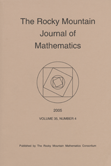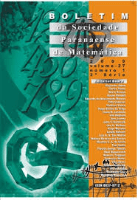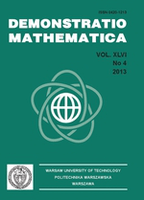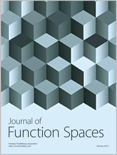
Sahand Communications in Mathematical Analysis
Scope & Guideline
Elevating research standards in mathematical analysis.
Introduction
Aims and Scopes
- Mathematical Inequalities:
The journal frequently publishes studies on various types of inequalities, including Ostrowski-type, Hermite-Hadamard inequalities, and inequalities involving fractional integrals, which are crucial for both theoretical developments and practical applications. - Fractional Calculus and Differential Equations:
A significant portion of the journal's content is dedicated to fractional calculus, exploring its applications in differential equations, population models, and dynamical systems, highlighting the increasing relevance of fractional models in modern mathematics. - Fixed Point Theory:
The journal extensively covers fixed point theorems and their applications in various mathematical contexts, including non-expansive mappings and hybrid contractions, which are essential for solving complex mathematical problems. - Function Spaces and Operators:
Research on various function spaces, including fuzzy normed spaces and Banach spaces, along with studies on operator theory, is a consistent theme, reflecting the journal's commitment to foundational aspects of mathematical analysis. - Applications in Probability and Statistics:
The journal also emphasizes the intersection of mathematical analysis with probability theory and statistical methods, showcasing how advanced mathematical techniques can be applied to solve problems in these fields.
Trending and Emerging
- Fractional Calculus and Its Applications:
There is a marked increase in research focusing on fractional calculus, particularly its applications in modeling real-world phenomena such as biological systems and dynamical behaviors, highlighting its relevance in contemporary mathematics. - Fuzzy Mathematics and Its Implications:
The rise of fuzzy mathematics, including fuzzy metric spaces and fuzzy functional analysis, indicates a growing interest in dealing with uncertainty and imprecision in mathematical models, which is increasingly relevant in various applied fields. - Computational Techniques and Numerical Methods:
A trend towards integrating numerical methods and computational techniques with theoretical analysis is evident, showcasing the journal's commitment to practical applications of mathematical theories. - Generalized Functions and Operator Theory:
Research on generalized functions, operators, and their applications in various spaces has gained momentum, reflecting an interest in modern approaches to traditional problems in analysis.
Declining or Waning
- Classical Analysis Techniques:
There seems to be a waning focus on classical analysis techniques that do not incorporate modern applications or methodologies, as newer approaches and interdisciplinary applications gain traction. - Basic Functional Analysis:
Basic results in functional analysis, which were once prevalent, appear less frequently as the emphasis shifts towards more complex and applied topics, such as fuzzy analysis and fractional calculus. - Traditional Summability Methods:
The exploration of traditional summability methods and their applications has decreased, possibly due to the rise of more advanced and nuanced techniques in convergence and approximation theory.
Similar Journals

Fixed Point Theory
Unlocking the Potential of Fixed Point ApplicationsFixed Point Theory, published by HOUSE BOOK SCIENCE-CASA CARTII STIINTA, is a distinguished journal that has garnered attention in the fields of mathematical analysis, applied mathematics, and computational mathematics. With an ISSN of 1583-5022 and an E-ISSN of 2066-9208, this journal serves as a vital platform for disseminating innovative research and significant developments in fixed point theory and its numerous applications. Its emergence as a Q3-ranked journal in 2023 across multiple categories indicates its growing influence within the academic community, particularly in Romania and beyond. Researchers, professionals, and students alike will find Fixed Point Theory an essential resource for staying abreast of the latest findings, methodologies, and theoretical advancements in these critical areas of mathematics, fostering a deeper understanding and stimulating further exploration in both foundational and applied settings.

ROCKY MOUNTAIN JOURNAL OF MATHEMATICS
Navigating the Landscape of Mathematical DiscoveryROCKY MOUNTAIN JOURNAL OF MATHEMATICS, published by the Rocky Mountain Math Consortium, serves as a critical platform for researchers and practitioners in the field of mathematics since its inception in 1971. With a notable presence in the academic community, this journal covers a broad spectrum of mathematical disciplines, positioning itself in the Q2 category for Mathematics (miscellaneous) as of 2023. Despite being a subscription-based journal, it is recognized for its rigorous peer-review process and contributions to theoretical and applied mathematics, helping to advance knowledge and foster collaboration among mathematicians. The journal's ISSN number is 0035-7596 and its E-ISSN is 1945-3795, reflecting its commitment to accessibility and dissemination of high-quality research. Based in Tempe, Arizona, at Arizona State University, the journal continues to play an important role in shaping contemporary mathematical discourse through well-researched articles and innovative studies, aiming to bridge gaps between various mathematical subfields and engage a diverse audience, including students and established researchers alike.

Bulletin of Mathematical Analysis and Applications
Fostering Collaboration for Groundbreaking DiscoveriesBulletin of Mathematical Analysis and Applications is a distinguished academic journal published by UNIV PRISTINA, DEPT MATHEMATICS COMPUTER SCIENCES, located in the vibrant city of Prishtina, Kosovo. This journal is dedicated to the dissemination of groundbreaking research in the fields of Mathematical Analysis and Applied Mathematics, focusing on both theoretical and practical aspects of these disciplines. While currently categorized in the Q4 quartile for analysis, applied mathematics, and miscellaneous mathematics, the journal is on an upward trajectory, welcoming contributions from researchers and professionals who strive to advance the frontiers of mathematical knowledge. Though its Open Access status is still to be developed, the journal remains committed to fostering a scholarly environment that promotes collaboration and innovation. With convergence years set from 2019 to 2024, the Bulletin of Mathematical Analysis and Applications aims to be an essential resource for those pursuing advancements in mathematics, providing a platform for new ideas and methodologies to flourish.

Boletim Sociedade Paranaense de Matematica
Championing Open Access in Mathematical ResearchBoletim Sociedade Paranaense de Matematica is a distinguished journal within the field of Mathematics, published by the Sociedade Paranaense de Matemática in Brazil. With an ISSN of 0037-8712 and an E-ISSN of 2175-1188, this journal has been committed to fostering open access to mathematical research since 2002, ensuring that cutting-edge research is readily available to the academic community. Operating within the diverse landscape of mathematical studies and ranked Q3 for 2023 in the category of Mathematics (Miscellaneous), the journal serves as a platform for innovative contributions and discussions. It ranks 192nd out of 399 in the Scopus database for General Mathematics, reflecting its steady involvement in the global academic dialogue. The Boletim resides at JD AMERICAS, CAIXA POSTAL 19081, CURITIBA PR 81531-990, Brazil, and aims to connect researchers, practitioners, and students by promoting high-quality research and dissemination of mathematical knowledge. By bridging diverse mathematical theories and applications, the journal not only enhances understanding of the discipline but also drives future research directions.

Demonstratio Mathematica
Fostering Collaborative Insights in MathematicsDemonstratio Mathematica, published by DE GRUYTER POLAND SP Z O O, is an esteemed open-access journal in the field of mathematics, with an ISSN of 0420-1213 and E-ISSN 2391-4661. Established in 1996 and providing open access since 2009, it has become a vital platform for disseminating innovative research and advancements in various areas of mathematics. With a commendable Scopus ranking of 85/399 in General Mathematics and a 2023 Category Quartile of Q2, it stands at the forefront of the mathematical community, demonstrating a significant impact within the top 78th percentile. The journal aims to foster a deeper understanding and appreciation of mathematical concepts and their applications, catering to both seasoned researchers and emerging scholars. Located in Warsaw, Poland, Demonstratio Mathematica not only enriches the academic discourse but also strengthens collaborative efforts within the international mathematics community, making it an essential resource for those seeking to expand their knowledge and research output.

POTENTIAL ANALYSIS
Advancing Insights in Potential TheoryPOTENTIAL ANALYSIS is a prestigious academic journal dedicated to the field of mathematical analysis, published by Springer. With the ISSN 0926-2601 and E-ISSN 1572-929X, this journal serves as a pivotal platform for scholars to disseminate cutting-edge research and advancements in potential theory, providing insights that bridge theoretical mathematics and applied analysis. Since its inception in 1992, POTENTIAL ANALYSIS has consistently maintained a high impact factor, boasting a Q1 rating in the 2023 category of Analysis, signifying its influence and reputation among its peers. It ranks 76 out of 193 in the Mathematics Analysis category in Scopus, placing it within the 60th percentile, which attests to the journal's commitment to quality and rigorous peer-review processes. While access to its articles is not open, it remains an essential resource for researchers, professionals, and students aiming to expand their understanding of potential theory and its applications in various fields. The journal's ongoing publication until 2024 promises a continual flow of innovative research, underpinning its role as an invaluable asset in the mathematical community.

TWMS Journal of Pure and Applied Mathematics
Pushing Boundaries in Pure and Applied MathematicsWelcome to the TWMS Journal of Pure and Applied Mathematics, a distinguished publication dedicated to advancing the field of mathematics through rigorous research and innovative applications. Published by the esteemed Institute of Applied Mathematics, this journal provides a platform for scholars and practitioners alike to share their findings and insights in both pure and applied mathematical disciplines. With a commitment to quality and integrity, the journal seeks to enhance the visibility and impact of mathematical research, reflected in its scholarly output. Although currently not an Open Access journal, the TWMS Journal aims to feature high-impact articles that contribute to both theoretical understanding and practical implementation. The journal’s address is located at Baku State University, ensuring its roots in a vibrant academic environment in Azerbaijan. As an essential resource in the mathematics community, the TWMS Journal of Pure and Applied Mathematics invites contributions that push the boundaries of knowledge and foster dialogue among researchers, professionals, and students.

Journal of Function Spaces
Championing Open Access in Function Spaces ScholarshipWelcome to the Journal of Function Spaces, an esteemed publication dedicated to advancing the field of mathematical analysis with a specific focus on function spaces. Published by HINDAWI LTD since 2003, this open access journal benefits from an extensive global readership, enabling researchers, professionals, and students to freely share and access influential research. With an impressive Scopus rank of #16 out of 193 in the Mathematics - Analysis category, and positioned in the Q3 quartile, the journal confirms its status as a valuable resource within the academic community. The journal fosters high-quality research aimed at elucidating various aspects of function spaces, thus contributing significantly to the theories and applications foundational in modern analysis. With its headquarters in London, England, it embraces innovation and accessibility, aiming to facilitate a collaborative environment for scholars to disseminate their work effectively. We invite you to explore the latest findings and contribute to the enriching discourse within this essential domain.

Constructive Mathematical Analysis
Unlocking New Perspectives in Constructive Mathematical ScienceConstructive Mathematical Analysis is a distinguished open-access journal dedicated to advancing the field of mathematical analysis, specifically through constructive methods. Published by Tuncer ACAR and affiliated with Selcuk University in Turkey, this journal has been making a significant impact in the academic community since its inception in 2018. With an emerging presence in Scopus, it has earned a Q2 ranking in key categories including Analysis, Applied Mathematics, and Numerical Analysis for 2023, reflecting its commitment to high-quality research contributions. By providing a platform for innovative research and interdisciplinary approaches, "Constructive Mathematical Analysis" aims to facilitate collaboration among researchers, educators, and students in their pursuit of knowledge in mathematical science. With its open-access model, the journal ensures that research findings are accessible to a global audience, fostering an inclusive academic environment.

Jordan Journal of Mathematics and Statistics
Illuminating Contemporary Challenges in Mathematics.The Jordan Journal of Mathematics and Statistics, published by Yarmouk University, Deanship of Research & Graduate Studies, serves as a pivotal platform for researchers and scholars in the fields of Mathematics and Statistics. With the ISSN 2075-7905 and E-ISSN 2227-5487, the journal seeks to disseminate original research findings and innovative methodologies across various branches of Applied Mathematics, Statistics, and related disciplines. Despite its Q4 categorization in the 2023 Scopus rankings, it bolsters a keen interest to enrich the academic community's understanding of contemporary statistical challenges, fostering an inclusive environment for idea exchange. The journal encourages submissions that promote theoretical advancements as well as practical applications, thus appealing to a diverse audience. Researchers, educators, and students seeking to stay abreast of current trends in mathematics and statistics will find this journal an invaluable resource in Jordan and beyond.